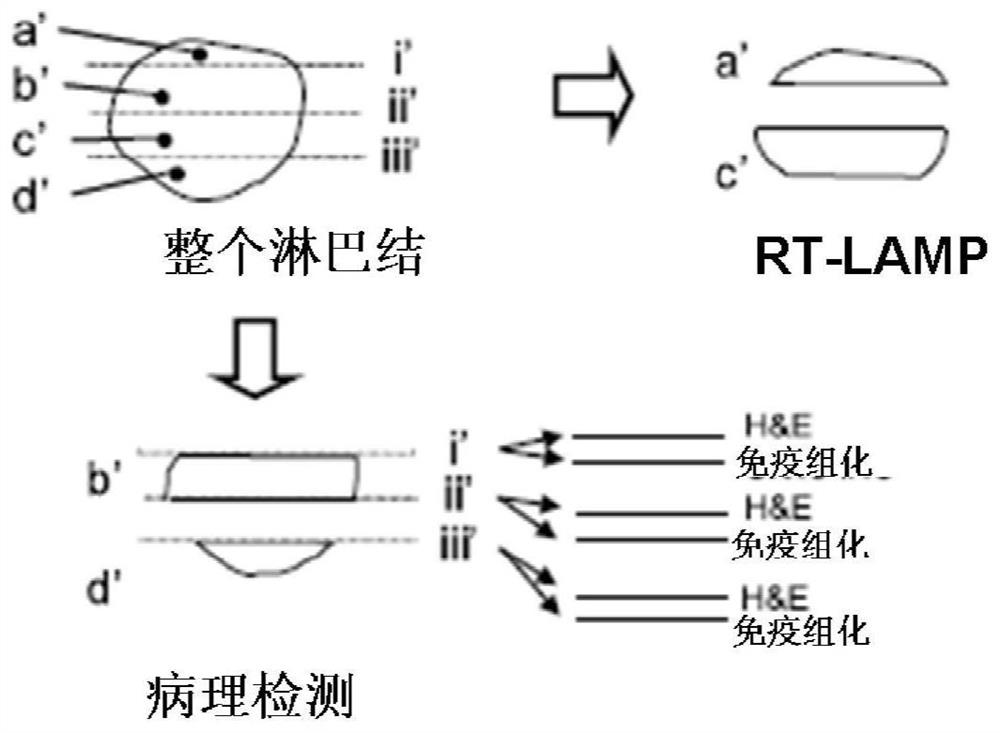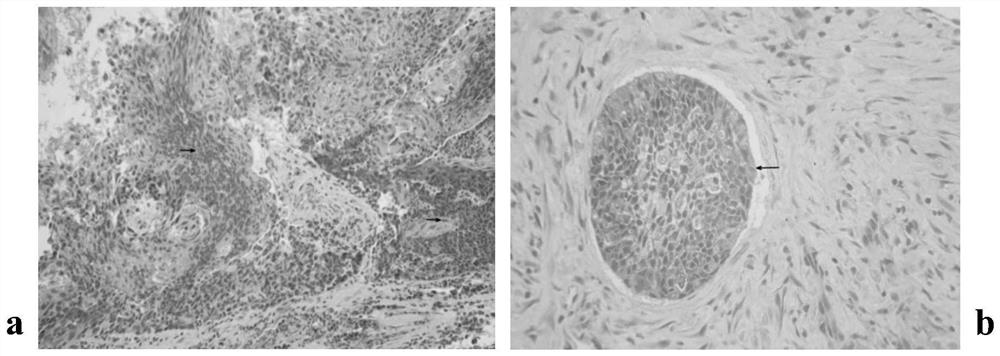A set of lamp primers ck7-18 for rapid detection of lymph node metastasis in head and neck squamous cell carcinoma
A technology for squamous cell carcinoma and lymph node metastasis, which is applied in the fields of life science and clinical medicine, and can solve problems such as unfavorable intraoperative progress
- Summary
- Abstract
- Description
- Claims
- Application Information
AI Technical Summary
Problems solved by technology
Method used
Image
Examples
Embodiment 1
[0048] Example 1: collection and preservation of specimens
[0049] Fresh surgically resected specimens were collected, including head and neck tumor tissue, paracancerous tissue, normal pericancerous tissue, and cervical lymph node tissue. After the tissue specimens are taken, it is first necessary to determine the tumor location, extent, and infiltration that can be distinguished by the naked eye from the clinician, and describe and record them.
[0050] 1. Collection of tumor, paracancerous and pericancerous normal tissues:
[0051] Specimens were collected in accordance with the principle of "pericancer-adjacent cancer-tumor tissue". In order to ensure the mRNA activity of the specimen and determine the pathological characteristics of the tissue, the collected tissue specimens need to be processed as follows: 1) Take samples from the obvious parts of the tumor tissue (not necessarily the central part), avoiding the necrotic part; 2) Take a slightly larger cube or cuboid ...
Embodiment 2
[0065] Example 2: Screening of specific marker genes for HNSCC lymph node metastasis
[0066] 1. Identification of candidate genes
[0067] Possible mRNA markers for detection of HNSCC lymph node metastasis were identified by literature reports and database searches. Search sources include: PubMed, OMIM, UniGene, GeneCards, CGAP. The principle of pre-selection of candidate genes is that the expression of the gene in HNSCC is abnormal compared with normal lymph node tissue, that is, high expression or low expression, or the gene is up-regulated or down-regulated in HNSCC and has unique tissue specificity, or the gene has tumor-specific sex. Based on the above principles, a total of 39 candidate genes were pre-selected (see Table 1).
[0068] Table 1. Candidate genes for primary screening studies
[0069]
[0070] 2. qRT-PCR experiment to screen candidate genes twice
[0071] The specific experimental method is briefly described as follows:
[0072] 1) The first genetic...
Embodiment 3
[0122] Embodiment 3: Establishment of LAMP detection process
[0123] On the basis of determining the CK7, CK19 and CK7+CK19 gene combinations, we started to establish the LAMP experimental process. The establishment of the whole process includes three aspects: the preparation of the buffer solution of the experimental kit, the design of CK19 and CK7 primers, and the determination of the optimal reaction temperature. The core of which is the primer design. In the screening experiment of the best primers, the appropriate buffer solution and the best reaction temperature are obtained at the same time. 54 cases of tumor tissues from 36 HNSCC patients and 31 cases of benign lymph node tissues from 15 non-cancer patients were selected in the process establishment experiment, and the optimal primers and test reaction conditions were screened by establishing the RT-LAMP reaction system. The inclusion criteria of patients were the same as before.
[0124] 1) Primer design
[0125] ...
PUM
 Login to View More
Login to View More Abstract
Description
Claims
Application Information
 Login to View More
Login to View More - R&D Engineer
- R&D Manager
- IP Professional
- Industry Leading Data Capabilities
- Powerful AI technology
- Patent DNA Extraction
Browse by: Latest US Patents, China's latest patents, Technical Efficacy Thesaurus, Application Domain, Technology Topic, Popular Technical Reports.
© 2024 PatSnap. All rights reserved.Legal|Privacy policy|Modern Slavery Act Transparency Statement|Sitemap|About US| Contact US: help@patsnap.com










